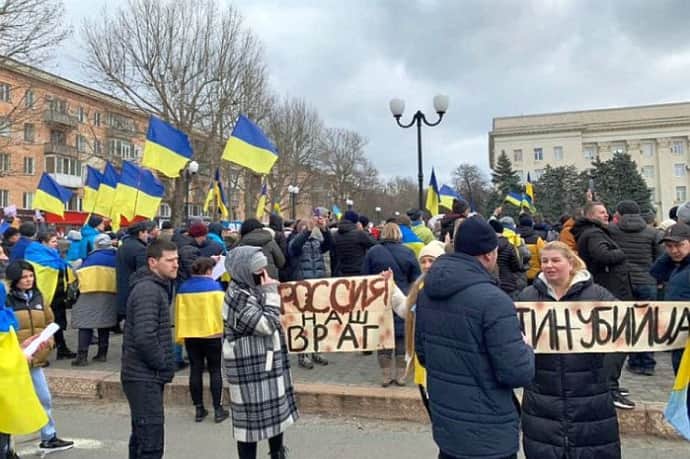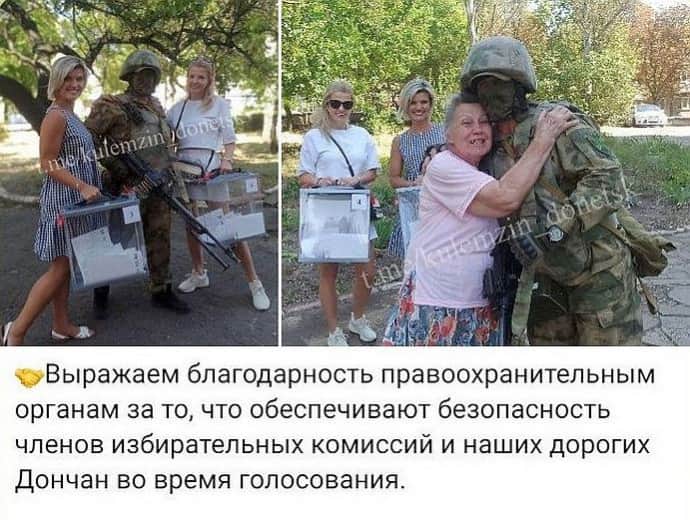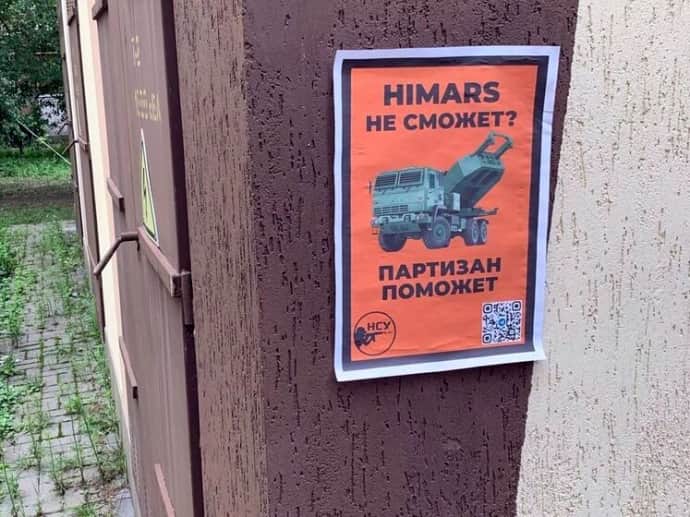How Ukrainian partisans are helping to liberate Ukraine
In early August 2023, five Russian units on Dzharylhach Island in Kherson Oblast were hit by HIMARS (US High-Mobility Artillery Rocket Systems). A video released by Ukraine's National Resistance Center shows the occupiers lining up and training just before the rockets struck. Many of the details behind the scenes of this special operation are classified, but some can already be disclosed.
"Put it this way, some people got hold of a USB flash drive [for official use only - Ukrainska Pravda]," says "Ostap", a spokesman for the National Resistance Center. "It fell into good hands in a cafe where some Russians were drinking. It was full of data about training: dates, places, which personnel were involved, officers, equipment."
Advertisement:The centre where Ostap works is a military organisation that operates within the Special Operations Forces to support non-violent resistance, one of the elements of national resistance that was legalised in Ukraine in July 2021. In this interview with Ukrainska Pravda, an officer of the Special Operations Forces who is the spokesman for the Central Security Service's National Resistance Center tells us how a partisan IT worker helped the Armed Forces of Ukraine to make Chornobaivka famous around the world.
How ordinary Ukrainians have thwarted the Russians' plans for an easy and total occupation of Ukraine. And how the occupiers are adapting to a life where there is strong resistance from the Ukrainian underground. These are the officer's own words.
Sabotage
The military can't succeed without the support of the local population - this is self-evident.
Even non-violent resistance is a highly effective mechanism for fighting the enemy. Firstly, passing on information about the location and number of equipment and personnel is important. We explain how to do it, and by what means, to be effective and as safe as possible.
Secondly, there's psychological pressure: graffiti, patriotic or threatening flyers, Ukrainian symbols. Thirdly, slowing down the Russians' advance. This is what foresters in Sumy Oblast did, for example - they chopped trees down, preventing whole columns from getting through.
Speaking of sabotage, I often recall the case of the Citroen truck factory during World War II. To undermine the Germans, dipsticks were installed on the trucks that showed they had sufficient oil in their tanks. In fact, the engines were running on minimum volumes, and after a while they would break down en masse.
 March 2022. Kherson residents show the Russians that they are not happy to see them: the signs read "Russia is our enemy" and "Putin is a murderer".Photo: HERSON.DEPO
March 2022. Kherson residents show the Russians that they are not happy to see them: the signs read "Russia is our enemy" and "Putin is a murderer".Photo: HERSON.DEPO
There are many methods of sabotage. With the right approach, everyone can be effective wherever they are.
If you are a plumber, then you definitely won't need our advice on how to arrange things so that "all of a sudden", everything in the occupiers' office is filled with shit and the premises are out of order for a few days. But that's a theoretical example. In the temporarily occupied territories of the Kherson region, there have been cases of electricians disabling the power grid.
Utility workers failed to repair the premises of the new "administrations", blaming a shortage of materials and fuel. One hospital director simulated a Covid epidemic in order to avoid treating Russians. We had this extraordinary guy in Chornobaivka.
When Russian forces entered the city, he and his friends hacked into the surveillance cameras at the airport. He changed the plates on all the panel boards, and while the Russians were looking for where the access was, he broadcast a video online. We gave him Mavik drones during the occupation.
He learned how to control them and adjusted the fire on the airfield. He's alive today and doing well.
Simulacrum
Since 24 February 2022, national resistance has become a mass phenomenon. In the spring of 2022, our manual on the National Resistance Center website, whose primary function is "educational", was downloaded 100,000 times.
And then it was copied and distributed. We are proud of how fast the resistance movement has grown. Immediately after the invasion, we had a lot of communications and phone calls [with the temporarily occupied territories - Ukrainska Pravda].
There was something akin to a network, with "foremen" and "bosses". But then it took off to such an extent that we don't control probably about 80% of what happens. That is, people structure their own work, take the initiative.
They pass on information, distribute flyers, daub graffiti. This is truly a patriotic war. The struggle of a society against the enemy who came to our land.
From the very beginning, this resistance made the Russians feel out of place, without support. It dawned on them that contrary to their expectations, the locals would not be coming out to greet the Russian army with flowers. This still causes cognitive dissonance for the Russians, because in their minds there must always be a "decision-making centre".
There is always someone who controls people. And if this centre can be found and eliminated, there will be no resistance. But in Ukraine, they came up against the fact that the resistance was truly civil.
And they still can't comprehend that. Non-violent resistance got results even during the so-called "referendums" in 2022, when Ukrainians ignored them and refused to open their doors [when local collaborators were coming round with soldiers and forcing people to vote at gunpoint - ed.]. Since then the occupying forces have been forced to make their rounds from house to house, citing "voter" security concerns.
And now they can't even create a mass picture [for propaganda purposes]. They don't need real voices, but images are important. That's why there are these "carousels", with the same people bussed in and filmed on camera over and over again.
This isn't even an imitation of an election: it's a simulacrum. Just a copy of something that doesn't exist. When anyone suggests disrupting these elections, I say, "You can't disrupt something that doesn't exist."
 The Telegram channel of Donetsk's Russian-appointed governor showed how sham elections are held in the "Russian world".
The Telegram channel of Donetsk's Russian-appointed governor showed how sham elections are held in the "Russian world".
The text reads: "We'd like to thank the law enforcement agencies for ensuring security for the electoral commissions and the people of Donetsk during the voting."
Synergy
We can't forbid an adult under occupation to take up a hunting rifle [to counter the occupiers - Ukrainska Pravda]. But we never advocate it. There have been cases of people spontaneously throwing Molotov cocktails at administrative buildings and military enlistment offices [under the rule of the Russians - Ukrainska Pravda].
There are people in the temporarily occupied territories who have been specially trained to perform combat missions, like the ones who recently blew up a car full of "ballot papers" in Nova Kakhovka, killing one Russian soldier and injuring two. We also explain to civilians taking part in non-violent resistance that safety comes first. The same military life skills and strategies are used here.
Is there a threat? Please abort the mission. Don't do anything.
All sorts of people pass on information. There are grandmas who know how to sweet-talk the Russians ("Our Russian boys!") and report to us. And there are some people who just never stop.
We had a female partisan in Kherson who, during the occupation, used to walk around wearing a Ukrainian Armed Forces T-shirt and drive her car with the windows down, playing Ukrainian music. She ended up in a basement. She was tortured there.
And then, when the Russians were fleeing, they just dumped her somewhere outside the city, and she walked back. There was a sweet old lady in Sumy who "invented" a second phone for herself that she called us from. She had a great fourth-floor location, and from her window she could see a lot of military vehicles and equipment constantly passing by.
She used to keep us informed. One day she said, "Look, guys, this city is so tiring. I'm going to a neighbouring village to stay with my friend." We said to her: "Where?
It's all mined around there." And she replied, "But I watched them doing the mining. I know where to walk there." So this lady disappeared for four days, and then she popped up again and began to supply information from that village. The two types of psychological pressure exerted on the Russians in the temporarily occupied territories - by civilian Ukrainians and our military operations - work in tandem.
When a Russian soldier walks through Melitopol and sees some trident graffiti, then reads about a car being blown up on Telegram, something clicks in his head. He realises that militant groups and civilians are both working against him. This synergy is powerful.
You can cover the whole town with flyers, but if there are no strikes, no military neutralisation in the rear, then the Russians will perceive those flyers as empty threats. And vice versa: if there are just car bombings and special operations and no civil resistance or protests, then the occupier will be convinced that he is only fighting the Armed Forces and the locals support him.
The regime
It's a lot more difficult to operate now than it was in the spring of 2022, because after the start of the invasion, it took the Russians a while to build up their administrative regime and police force. Now there are surveillance cameras even in towns and villages in the temporarily occupied territories.
There's a developed system of electronic warfare. There's a system that allows them to "rewind" data deleted from your phone almost a week ago. So it's important that those who pass on information to us know how to quickly reset their smartphone to factory settings.
The effect of all this is to restrict the ability to breathe freely. People who hold patriotic Ukrainian views are under constant threat. FSB agents in civilian clothes are infiltrated into queues, where they start talking about how bad the Russian government and the military are.
The person who joins in the conversation most actively and emotionally will be taken away to a basement. When the Russians realised that the locals had now learned the location of all the checkpoints, they created "mobile" versions. Minibuses and cars carrying personnel can stop at any place to start checks unexpectedly.
 A flyer in the temporarily occupied territories of Ukraine.
A flyer in the temporarily occupied territories of Ukraine.
It reads (in Russian): "HIMARS can't do it? The partisan can help"Picure: Defence Intelligence of Ukraine on Facebook
The pressure on the temporarily occupied territories increased with the Russians' failed attempts to foist Russian passports on Ukrainian citizens. It's patently absurd: they went on about unanimity at the "referendum", and now they keep insisting that people go and get Russian passports, by threatening physical violence, withholding medical care, and exacerbating the humanitarian crisis [by refusing to give out aid to those without Russian passports - ed.].
Many people are forced to accept Russian passports because they are being tortured and repressed. It's a matter of survival. In general, the occupiers have a big problem with collaborator professionals: doctors and other specialists.
So they bring in their own from the Russian Federation on rotation, enticing them over with money and benefits. Yes, there are some collaborators, conscious criminals. But the occupation administration constantly has to think about where to get people to work with, trying to persuade them, luring them in with money.
The number of people who agree is definitely not as many as they would like to see. Despite all the Russians' efforts, Ukrainians in the temporarily occupied territories continue to resist. The people are unwavering; they are waiting for the Armed Forces.
And they're not just waiting - they're helping, passing on information. It's important to talk about this. We should constantly remember the Ukrainians who live there.
For me, the height of heroism is when a person in Crimea, Luhansk or Donetsk, where an all-embracing totalitarian ideology has been created over a period of nine years, goes and hangs a yellow ribbon up in the street. We have no right to betray them. Yevhen Rudenko - Ukrainska Pravda
Translation: Elina Beketova
Editing: Teresa Pearce